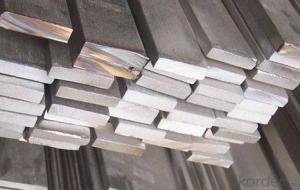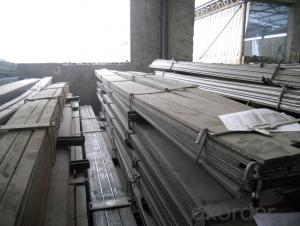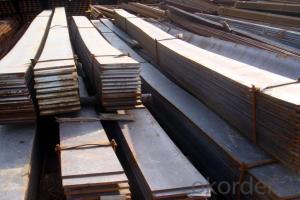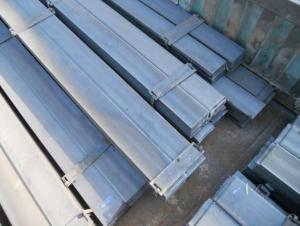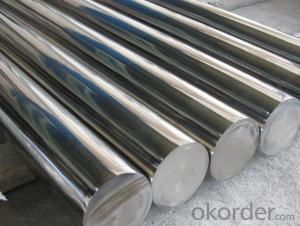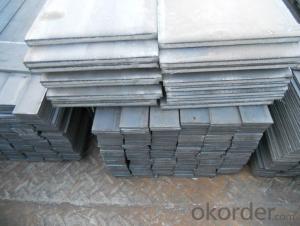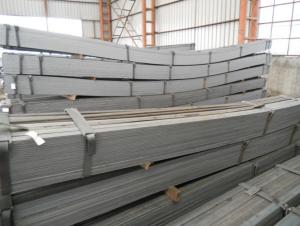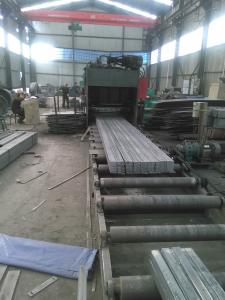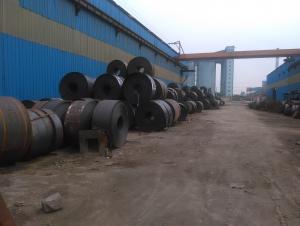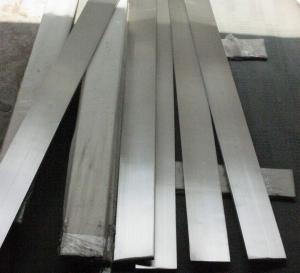Good Quality Special Steel Flat Bar For Automobile Used
- Loading Port:
- Shanghai
- Payment Terms:
- TT OR LC
- Min Order Qty:
- 50 m.t.
- Supply Capability:
- 1000 m.t./month
OKorder Service Pledge
OKorder Financial Service
You Might Also Like
Commodity: Carbon Steel Flat Bar For Car
Standard: GB, JIS, ASTM,
Material: Q235, SS400 or Equivalent
Origin place: China
Thickness: 3mm-30mm
Width:20mm-200mm
Length: Max 12m
Certification: SGS/BV
Chemical composition
Alloy No | Grade | Element(%) | ||||
C | Mn | S | P | Si | ||
Q235 | B | 0.12—0.20 | 0.3—0.7 | ≤0.045 | ≤0.045 | ≤0.3 |
Physical properties
Alloy No | Grade | Yielding strength point(Mpa) | Tensile strength (Mpa) | Elongation after fracture(%) | ||||||
Thickness (mm) | Thickness (mm) | |||||||||
≤16 | >16--40 | >40--60 | >60--100 | ≤16 | >16--40 | >40--60 | >60--100 | |||
≥ | ≥ | |||||||||
Q235 | B | 235 | 225 | 215 | 205 | 375--500 | 26 | 25 | 24 | 23 |
Usage/Applications of Flat Bar
Widely used for construction;
Machinery manufacturing;
Iron tower steel structure;
Shipbuilding; Steel grating;
Staircase;
Bridge;
Viaduct;
Railway spare parts;
Boilers making etc.
Packaging & Delivery
Packaging Details: The Steel Flat Bars are packed in bundles and loaded in 20 feet/40 feet container, or shipped by bulk cargo ,also we can do as customer's requirements.
Delivery Details:30~45 days upon the receipt of buyer payment by T.T. or L/C.
Production Flow
The Carbon Steel Flat Bar is made through three processes:
1.Feeding the material: Feeding the row material (the steel plate) to Slitting Line.
2.Slitting:The steel plate would be slitted into expected width by lengthways cutter.
3. Leveled and cutting: The plat bar would be ground into level by the grinder and then cut into required length.
FAQ:
Q1: Why buy Materials & Equipment from OKorder.com?
A1: All products offered byOKorder.com are carefully selected from China's most reliable manufacturing enterprises. Through its ISO certifications, OKorder.com adheres to the highest standards and a commitment to supply chain safety and customer satisfaction.
Q2: What makes stainless steel stainless?
A2: Stainless steel must contain at least 10.5 % chromium. It is this element that reacts with the oxygen in the air to form a complex chrome-oxide surface layer that is invisible but strong enough to prevent further oxygen from "staining" (rusting) the surface. Higher levels of chromium and the addition of other alloying elements such as nickel and molybdenum enhance this surface layer and improve the corrosion resistance of the stainless material.
Q3: Can fit in the containers of 20fts the steel beams of 6M?
A3: No proble, we can put them into the containers in the form sideling.


- Q: Are steel flat bars suitable for outdoor signage or displays?
- Yes, steel flat bars are suitable for outdoor signage or displays. Steel is a durable and weather-resistant material that can withstand outdoor conditions such as rain, wind, and sunlight. Additionally, steel flat bars provide a sturdy base for mounting signs or displays, making them a reliable choice for outdoor applications.
- Q: How do steel flat bars perform under extreme temperatures?
- Under extreme temperatures, steel flat bars typically demonstrate excellent performance. Steel is renowned for its remarkable strength and durability, enabling it to withstand a wide spectrum of temperatures. When subjected to high temperatures, steel flat bars maintain their structural integrity and strength, rendering them suitable for diverse applications in industries such as construction, manufacturing, and automotive. When exposed to intense heat, steel flat bars may experience thermal expansion, which is an inherent characteristic of metal materials. As the temperature rises, steel expands, and as it cools, it contracts. This expansion and contraction can be accounted for during the design and installation process to guarantee the proper fit and functionality. Furthermore, steel boasts a high melting point, usually around 1370°C (2500°F). Consequently, steel flat bars can endure extremely high temperatures without losing their shape or structural integrity. Nevertheless, it is crucial to note that prolonged exposure to elevated temperatures may diminish strength and potentially lead to deformation or warping. Therefore, it is vital to consider the specific application and temperature requirements when selecting steel flat bars for utilization in extreme temperature conditions. In frigid temperatures, steel flat bars also exhibit commendable performance. Steel retains its ductility and does not become brittle until exceedingly low temperatures, typically below -40°C (-40°F). This quality makes steel flat bars suitable for implementation in cold climates or freezing environments. In conclusion, steel flat bars generally exhibit excellent performance under extreme temperatures while retaining their strength and durability. However, it is imperative to consider the precise temperature range and application requirements to ensure optimal performance and longevity of steel flat bars.
- Q: Can steel flat bars be used for making staircases?
- Yes, steel flat bars can be used for making staircases. Steel flat bars are commonly used in construction and fabrication due to their strength and durability. They can be used as the main structural component for staircases, providing support and stability. Additionally, steel flat bars can be easily shaped and welded together to create the desired staircase design. They are also resistant to corrosion, making them suitable for both indoor and outdoor staircases. Overall, steel flat bars are a versatile and reliable choice for constructing staircases.
- Q: Are steel flat bars suitable for electrical conductivity applications?
- No, steel flat bars are not suitable for electrical conductivity applications. Steel is a poor conductor of electricity compared to other materials like copper or aluminum. While steel can conduct electricity to some extent, its conductivity is significantly lower than that of metals specifically designed for electrical applications. Therefore, it is recommended to use materials with higher electrical conductivity, such as copper or aluminum, for electrical conductivity applications.
- Q: Are steel flat bars available in different lengths and thicknesses?
- Yes, steel flat bars are available in different lengths and thicknesses.
- Q: Do steel flat bars have a specific surface hardness?
- Steel flat bars possess a distinct surface hardness, which is typically influenced by the particular grade or type of steel employed during their production. The hardness levels of different steel varieties differ, and these may be assessed with the aid of various scales, such as the Rockwell hardness scale. The surface hardness of steel flat bars holds significance, as it directly impacts their capacity to withstand wear, abrasion, and deformation. For achieving optimal performance and durability, it becomes vital to meticulously choose steel flat bars with the desired surface hardness grade, specific to the intended applications.
- Q: Can steel flat bars be used for making brackets or supports for electrical substations?
- Yes, steel flat bars can be used for making brackets or supports for electrical substations. Steel flat bars are known for their strength, durability, and load-bearing capacity, which makes them suitable for such applications. Additionally, steel is resistant to corrosion and can withstand harsh weather conditions, further enhancing its suitability for use in electrical substations.
- Q: Are steel flat bars suitable for earthquake-prone areas?
- Yes, steel flat bars are suitable for earthquake-prone areas. Steel is a strong and durable material that can withstand seismic forces better than other materials. Flat bars provide structural stability and can be used in various applications such as reinforcing structures, bracing walls, or constructing seismic-resistant frames.
- Q: What is the typical hardness of steel flat bars?
- The typical hardness of steel flat bars can vary depending on the specific grade and heat treatment, but generally, they range from 40 to 65 on the Rockwell hardness scale. This hardness level ensures that steel flat bars are strong, durable, and able to withstand various mechanical stresses and impacts. However, it is important to note that hardness can be adjusted through different heat treatment processes to meet specific requirements for different applications.
- Q: What is the maximum length available for steel flat bars?
- The maximum length available for steel flat bars can vary depending on the supplier and manufacturer. However, in general, steel flat bars are commonly produced in standard lengths of 20 feet or 6 meters. These lengths are widely available and suitable for a wide range of applications. Additionally, it is worth noting that some suppliers may offer custom cutting services, allowing customers to request specific lengths according to their project requirements.
Send your message to us
Good Quality Special Steel Flat Bar For Automobile Used
- Loading Port:
- Shanghai
- Payment Terms:
- TT OR LC
- Min Order Qty:
- 50 m.t.
- Supply Capability:
- 1000 m.t./month
OKorder Service Pledge
OKorder Financial Service
Similar products
Hot products
Hot Searches
Related keywords
